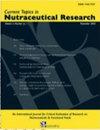Efficacy and Safety Evaluation of Different Maintenance Dose Regimens of Caffeine Citrate in the Treatment of Primary Apnea in Preterm Infants
IF 0.4
4区 医学
Q4 NUTRITION & DIETETICS
Current Topics in Nutraceutical Research
Pub Date : 2023-07-07
DOI:10.37290/ctnr2641-452x.21:266-271
引用次数: 0
Abstract
We have investigated the efficacy and safety of different maintenance doses of caffeine citrate in the treatment of primary apnea in preterm infants. To this end, apneic premature infants were treated with 5 mg/kg (low dose) or 10 mg/kg (high dose) caffeine citrate, and the frequency of apnea at 48 h and 72 h, improvement of clinical symptoms, respiratory mechanics parameters related to lung function, and blood gas analysis indexes were compared between the two groups, and safety was evaluated. The frequency of apnea at 48 h and 72 h was significantly lower in the high-dose group than in the low-dose group, and the difference was statistically significant (P < 0.05). The time to resolution of apnea, the time to mechanical ventilation, and the time to citrate use were significantly shorter in the high-dose group than in the low-dose group (P < 0.05). The tidal volume and peak expiratory flow values were significantly higher in the high-dose group than in the low-dose group (P < 0.05). The oxygen partial pressure and pulse oximetry levels in the blood gas analysis indexes of the high-dose group were significantly higher than those of the low-dose group, and the partial pressure of carbon dioxide level was significantly lower than that of the low-dose group, with statistically significant differences (P < 0.05). The safety evaluation results showed no significant difference in the rate of adverse reactions and short-term complications between the high-dose group and the low-dose group (P > 0.05). Caffeine citrate at a maintenance dose of 10 mg/kg can effectively reduce the frequency of apnea, shorten the improvement time of clinical symptoms, and improve the lung function and blood gas analysis level of children with a high safety profile.枸橼酸咖啡因不同维持剂量方案治疗早产儿原发性呼吸暂停的疗效和安全性评价
我们研究了不同维持剂量的柠檬酸咖啡因治疗早产儿原发性呼吸暂停的疗效和安全性。为此,用5 mg/kg(低剂量)或10 mg/kg(高剂量)柠檬酸咖啡因治疗呼吸暂停性早产儿,比较两组在48小时和72小时的呼吸暂停频率、临床症状的改善、与肺功能相关的呼吸力学参数和血气分析指标,并评估安全性。高剂量组48小时和72小时的呼吸暂停频率明显低于低剂量组,差异有统计学意义(P<0.05),高剂量组的潮气量和呼气峰流量值明显高于低剂量组(P<0.05),高剂量组血气分析指标中氧分压和脉搏血氧测定水平明显高于并且二氧化碳水平的分压显著低于低剂量组,差异有统计学意义(P<0.05)。安全性评价结果显示,高剂量组与低剂量组不良反应发生率和短期并发症发生率无显著差异(P>0.05)。柠檬酸咖啡因维持剂量为10mg/kg可有效降低呼吸暂停频率,缩短临床症状改善时间,并提高安全性高的儿童的肺功能和血气分析水平。
本文章由计算机程序翻译,如有差异,请以英文原文为准。
求助全文
约1分钟内获得全文
求助全文
来源期刊
CiteScore
1.10
自引率
0.00%
发文量
36
审稿时长
>12 weeks
期刊介绍:
Current Topics in Nutraceutical Research is an international, interdisciplinary broad-based peer reviewed scientific journal for critical evaluation of research on chemistry, biology and therapeutic applications of nutraceuticals and functional foods. The major goal of this journal is to provide peer reviewed unbiased scientific data to the decision makers in the nutraceutical and food industry to help make informed choices about development of new products.
To this end, the journal will publish two types of review articles. First, a review of preclinical research data coming largely from animal, cell culture and other experimental models. Such data will provide basis for future product development and/or human research initiatives. Second, a critical evaluation of current human experimental data to help market and deliver the product for medically proven use. This journal will also serve as a forum for nutritionists, internists, neurologists, psychiatrists, and all those interested in preventive medicine.
The common denominator of all of the topic to be covered by the journal must include nutraceuticals and/functional food. The following is an example of some specific areas that may be of interest to the journal. i) Role of vitamins, minerals, antioxidants and phytonutrients on cardiovascular health, cancer, diabetes, ocular health, mental health, men’s health, women’s health, infant nutrition, ii) Role of herbals on human health, iii) Dietary supplements and sleep, iv) Components of diet that may have beneficial effect on human health, v) regulation of apoptosis and cell viability, vi) Isolation and characterization of bioactive components from functional foods, vii) Nutritional genomics, and viii) Nutritional proteomics.

 求助内容:
求助内容: 应助结果提醒方式:
应助结果提醒方式:


